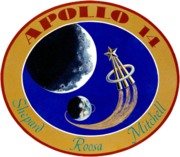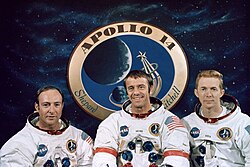Apollo 14
Apollo 14 was the eighth crewed mission in the Apollo program. It was the third mission to land on the Moon. The nine-day mission left the Earth on January 31, 1971, and landed on the Moon on February 5. The Lunar Module landed in the Fra Mauro formation; this had been the target of the ill-fated Apollo 13 mission. During the two walks on the Moon's surface, 93.2 lb (42 kg) of moon rock was collected. Several experiments, including seismic studies, were carried out. Commander Alan Shepard famously hit two golf balls on the lunar surface with a makeshift club he had brought from Earth. Command Module Pilot Stuart Roosa took several hundred seeds on the mission, many of which were planted on return, resulting in the so-called Moon trees.[2] The pilot of the Lunar Module was Dr. Edgar Mitchell.
 Shepard and the American flag on the Moon during Apollo 14 in February 1971 | |
| Mission type | Crewed lunar landing |
|---|---|
| Operator | NASA[1] |
| COSPAR ID |
|
| SATCAT no. |
|
| Mission duration | 9 days, 1 minute, 58 seconds |
| Spacecraft properties | |
| Spacecraft |
|
| Manufacturer | CSM: North American Rockwell LM: Grumman |
| Launch mass | 102,084 pounds (46,305 kg) |
| Landing mass | 11,481 pounds (5,208 kg) |
| Crew | |
| Crew size | 3 |
| Members | |
| Callsign |
|
| Start of mission | |
| Launch date | January 31, 1971 |
| Rocket | Saturn V |
| Launch site | Kennedy LC-39A |
| End of mission | |
| Recovered by | USS New Orleans |
| Landing date | February 9, 1971 |
| Landing site | South Pacific Ocean 27°1′S 172°39′W / 27.017°S 172.650°W |
| Orbital parameters | |
| Reference system | Selenocentric |
| Pericynthion | 16.9 kilometers (9.1 nmi) |
| Apocynthion | 108.9 kilometers (58.8 nmi) |
| Period | 120 minutes |
| Lunar orbiter | |
| Spacecraft component | Command and service module |
| Orbital insertion | February 4, 1971 |
| Orbital departure | February 7, 1971 |
| Orbits | 34 |
| Lunar lander | |
| Spacecraft component | Lunar module |
| Landing date | February 5, 1971 |
| Return launch | February 6, 1971 |
| Landing site | Fra Mauro 3°38′43″S 17°28′17″W / 3.64530°S 17.47136°W |
| Sample mass | 42.80 kilograms (94.35 lb) |
| Surface EVAs | 2 |
| EVA duration |
|
| Docking with LM | |
| Docking date | February 1, 1971 |
| Undocking date | February 5, 1971 |
| Docking with LM ascent stage | |
| Docking date | February 6, 1971 |
| Undocking date | February 6, 1971 |

 Left to right: Mitchell, Shepard, Roosa | |
LRO finds the site
changeIn June 2009, the NASA Lunar Reconnaissance Orbiter was able to photograph the Apollo 14 landing site. The base of the lunar module and the astronauts footprints on the Moon's surface could be clearly seen.[3]
References
change- ↑ Orloff, Richard W. (September 2004) [First published 2000]. "Table of Contents". Apollo by the Numbers: A Statistical Reference. NASA History Series. Washington, D.C.: NASA. ISBN 0-16-050631-X. LCCN 00061677. NASA SP-2000-4029. Archived from the original on September 6, 2007. Retrieved July 17, 2013.
{{cite book}}:|work=ignored (help) - ↑ "The Moon Trees". NASA. Retrieved 2009-12-23.
- ↑ "New images of Moon landing sites". news.bbc.co.uk. 18 July 2009. Retrieved 2009-07-19.